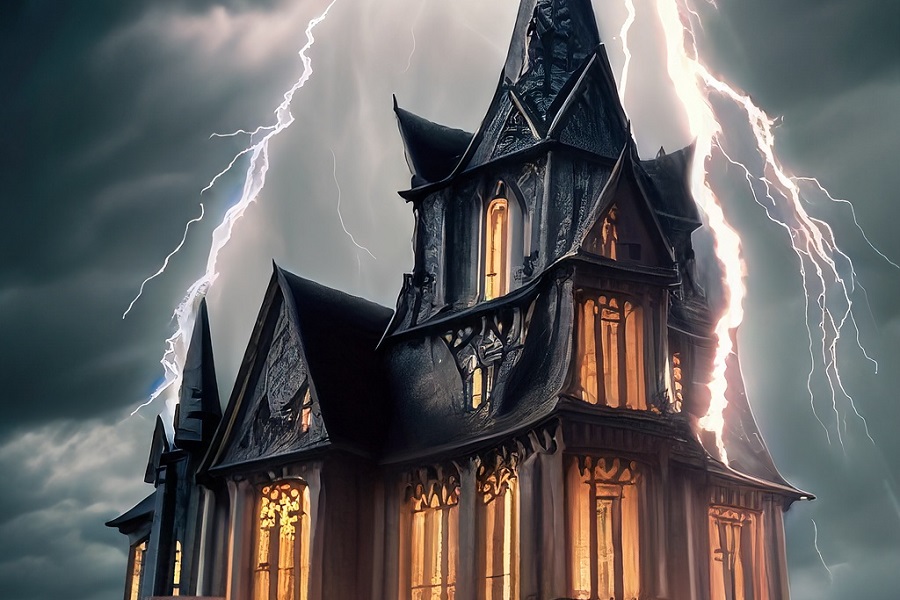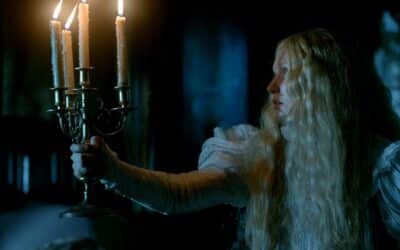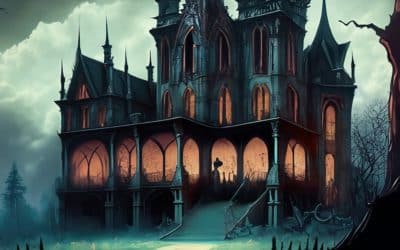
What Makes Fiction Gothic?
As night’s opaque veil descends and the air fills with an eerie sense of foreboding, the realm of Gothic fiction comes alive. While the genre may be awash in black velvet cloaks, spectral apparitions, and crumbling castles, the dark enchantment of Gothic fiction extends beyond the mere veneer of its gloomy aesthetics.
At its pulsing heart, Gothic fiction is a wild tangle of elements, where sublime landscapes intersect with psychological terror. The genre is distinguished by its provocative exploration of the grotesque, the supernatural, and the desolate, all wrapped up in a narrative teetering between romance and horror. Still, if one scratches below the surface, there’s a disquieting familiarity beneath the shadowy cloak of Gothic fiction that’s both haunting and deliciously enticing.
Think of Gothic fiction as the tantalizing unknown at the end of a dimly lit hallway, as the shiver that tiptoes down your spine when you step into an abandoned mansion. It draws on the mysterious, the ghastly, and the thrilling, then delicately stirs these elements into a spellbinding brew. But where does this distinct allure originate? In the treacherous waters of fear and desire, or the blurred boundary between sanity and madness?
Gothic fiction sprouted its chilling roots in the 18th century, with Horace Walpole’s seminal work “The Castle of Otranto” paving the way. It was a response to the rationalism of the Enlightenment era, an escape hatch that plunged readers into the realms of emotion, imagination, and the supernatural. The genre offered the perfect canvas to explore dark romanticism, a movement fascinated by nature’s wilderness, the mysteries of the psyche, and humanity’s innate imperfections.
Imagination is the pulsating lifeblood of Gothic fiction, often cloaked in the sublime – a concept beautifully summed up by the philosopher Edmund Burke as the fine line between delight and horror, stirred by the awe-inspiring and terrifying aspects of life. And oh, how Gothic fiction dances on this knife’s edge! It weaves a dark tapestry, deftly merging the eerie and the alluring, luring its audience into an intoxicating trance.
Central to the genre are its potent symbols and themes. Gothic fiction revels in dilapidated buildings, such as castles, monasteries, and mansions, teetering on the precipice of decay. These structures not only provide a chilling backdrop but also symbolize societal collapse, unbridled passions, and the haunted human mind. Think Mary Shelley’s “Frankenstein”, where Victor Frankenstein’s unbounded scientific ambition spirals into monstrosity, echoing in the unforgiving desolation of the Arctic.
Additionally, Gothic fiction dips its quill into the inkwell of terror and suspense. It understands that anticipation is often more potent than the actual revelation, utilizing suspense as a narrative engine. The ever-present sense of impending doom, of secrets trapped within creaky floorboards and behind cobwebbed doorways, serves as a powerful undercurrent, yanking readers deeper into the labyrinth.
It’s worth noting that the eponymous ‘Gothic’ of Gothic fiction doesn’t refer to the historical Goths, known for their destructive approach to Roman civilization. Instead, it harkens back to the medieval, or the ‘Gothic’ era. The genre is enthralled by the idea of the past’s spectral fingerprints on the present, the past’s inability to stay buried, which erupts into the present with terrifying consequences.
But it’s not all just gloom and doom. Gothic fiction interlaces the macabre with a strand of undeniable romance. This romance doesn’t shimmer with soft candlelight or ring with the gentle strumming of a lute. No, it thrives on intensity and uncertainty, a passionate maelstrom often threatening to consume the characters. Emily Brontë’s “Wuthering Heights” embodies this aspect beautifully, casting a tale of love as haunting as the windswept moors it’s set on.
Now, let’s also appreciate the Gothic heroine, who is frequently positioned at the heart of these stormy narratives. She’s often caught in a struggle, a web spun from societal constraints, family secrets, and her own desires. The Gothic heroine’s journey, like that of Edith Cushing in Guillermo del Toro’s modern Gothic masterpiece, “Crimson Peak”, involves navigating fear, innocence, and the unveiling of grim secrets.
Moreover, Gothic fiction has proven a fertile soil for the exploration of the other, the alien, and the monstrous. The genre’s horror-tinged palette is well-suited for analyzing societal fears and prejudices. From Stoker’s ‘Dracula’ personifying fears of the foreign, to Shelley’s ‘Frankenstein’ exposing the monstrous face of unchecked ambition, Gothic fiction has always tapped into the pulse of societal anxieties.
In essence, Gothic fiction is the literary embodiment of chiaroscuro, the art technique that plays with stark contrasts between light and dark. This genre coalesces romance with horror, beauty with decay, and the natural with the supernatural, all while unearthing the shadowy corners of human nature. It serves as an antique mirror, reflecting our deepest fears and desires, cloaked in a mesmerizing play of shadows and light.
The allure of Gothic fiction, therefore, resides in its paradoxical nature. It terrifies and yet enchants, distresses yet compels. Like a specter in a moonlit graveyard, it haunts the imagination long after the story ends, reminding us of the intriguing abyss that lingers at the edge of the ordinary, waiting to be explored.
So, the next time you pick up a Gothic novel and step into its eerie embrace, remember – you’re not merely reading a tale. You’re embarking on a journey that skirts the boundaries of the known and the unknown, the rational and the fantastical, the beautiful and the grotesque. This is the captivating realm of Gothic fiction – a mirror that reflects our darker selves in the most beguiling way. It’s no wonder then that we are, and will likely remain, entranced by its dark allure.
Delving into the Masterpieces of Gothic Suspense Fiction
Do you feel that? It’s a chill in the air, an uncanny whisper of the ancient and the arcane. Our cryptic journey has just begun, dear reader, so dust off your lanterns and summon your courage as we plunge into the spectral realm of Gothic suspense fiction.
Gothic suspense fiction, with its haunting symphony of the macabre and the uncanny, is like a blood-red thread running through the tapestry of literature. It’s not merely a genre; it’s an experience. A tempest of trembling anticipation, a labyrinth of darkly romantic echoes, and a celebration of the delicious thrill of the unknown.
Where, you might ask, should we begin our descent into this realm of shadows and whispers? Let’s start our exploration with the book that’s often hailed as the mother of all Gothic suspense fiction – “The Castle of Otranto” by Horace Walpole. Published in 1764, it laid the groundwork for the genre with its brooding castle, supernatural omens, and a plot bristling with suspense. Its twisted corridors and mysterious chambers introduced readers to the intoxicating pleasure of exploring the unknown, the thrill of a chilling mystery unraveled by flickering candlelight.
Fast-forward to the 19th century, the golden era of Gothic suspense fiction, where literary titans like Edgar Allan Poe and Mary Shelley reigned supreme. Poe, with his tales of psychological torment and eerie mysteries, gifted us masterpieces like “The Fall of the House of Usher”. It’s a story simmering with suspense, an uncanny blend of the human psyche’s fragility and a haunted house’s oppressive gloom. Poe’s genius lay in the masterful manipulation of suspense, the uncanny ability to make readers’ pulses race with every rustle of the wind, every mournful echo in desolate halls.
Meanwhile, Shelley’s “Frankenstein” is a marvel that splices suspense with elements of horror and science fiction. Here, suspense is a living, breathing entity, keeping readers on edge as they accompany Victor Frankenstein on his tragic journey. From the unsettling creation scene to the chilling chase in the Arctic wilderness, “Frankenstein” is a masterstroke in maintaining an atmosphere of dread and anticipation.
Entering the 20th century, we see the baton of Gothic suspense fiction pass to writers like Daphne du Maurier, who wove intricate tales of psychological suspense set against moody, Gothic backdrops. Her novel, “Rebecca”, is an iconic example. From the moment the unnamed narrator arrives at the foreboding Manderley estate, du Maurier has readers teetering on a tightrope of suspense. The lingering ghost of Rebecca and the mansion’s oppressive atmosphere make for an exhilarating, pulse-pounding read.
A conversation about Gothic suspense fiction would be incomplete without the mention of “The Haunting of Hill House” by Shirley Jackson. Here, the suspense is so tangible it’s almost another character, permeating every corner of the eerie mansion. From the opening line, Jackson skillfully entwines the readers’ nerves around her narrative, not releasing the pressure until the book’s final, shattering climax.
But let’s not overlook the contemporary avatars of Gothic suspense fiction, carrying forward the genre’s legacy with panache. Carlos Ruiz Zafón’s “The Shadow of the Wind” takes us through the winding streets of post-war Barcelona, spinning a tale of suspense, mystery, and Gothic romance. It showcases how the essence of Gothic suspense fiction – an eerie setting, a haunting mystery, and the relentless build-up of suspense – can still be reimagined in a fresh, compelling way.
More recently, Mexican Gothic by Silvia Moreno-Garcia, is a stunning embodiment of how the genre continues to evolve. This novel ingeniously blends traditional Gothic suspense elements with the lush vibrancy of Mexican folklore. The tale, rich in suspense and creeping horror, revolves around a formidable mansion nestled in the Mexican countryside, reinforcing the genre’s enduring allure.
Exploring these brilliant works of Gothic suspense fiction, it’s clear why the genre continues to captivate readers. It’s not simply about being spooked by spectral apparitions or feeling uneasy in a gloomy castle. It’s the tantalizing dance of suspense, the beckoning whisper of mystery, and the psychological exploration that keeps readers gripped. It is the thrill of deciphering clues shrouded in shadows, of navigating the labyrinthine corridors of suspense, and the electrifying moment of revelation that draws us back to these tales, time and again.
So the next time the evening draws in and a mysterious fog creeps over the landscape, why not reach for a book from this shadowy genre? As you flip the pages and the suspense starts to weave its spell, remember – you’re not just reading a Gothic suspense novel. You’re unlocking a cryptic puzzle, one shrouded in shadows and secrets. You’re not just a reader, but a fearless explorer, ready to delve into the hauntingly beautiful labyrinth of Gothic suspense fiction.
More Gothic Features
Gothic Mystery Settings
The power of place in gothic mysteries
Victorian Gothic
Victorian gothic in suspense and horror
Gothic Crime
Gothic Crime Fiction: A Genre That Haunts and Thrills



